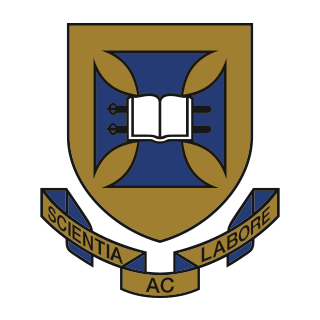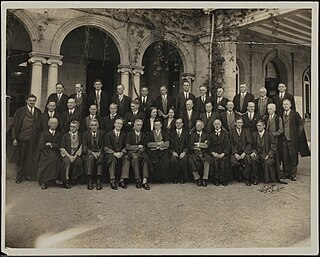
The University of Queensland Seismology Station was established in 1938 at the University of Queensland, Brisbane, Australia. [1]

The University of Queensland Seismology Station was established in 1938 at the University of Queensland, Brisbane, Australia. [1]
The University of Queensland Seismology Station is a long term research project of the University, second only to the Pitch Drop experiment. The station was established following the Gayndah earthquake of 12 April 1935. [2] W.H. Bryan, who was a lecturer in Geology at the University of Queensland, undertook an investigation into the earthquake, distributing a questionnaire to those affected by it, and undertook field investigations. [3] This was done to establish the epicentre of the earthquake, and its cause and effects. Newspaper coverage of the event was extensive in 1935, and following on from an interview with W.H. Bryan, a donor presented a Milne-Shaw Seismograph to the University to aid their continuing research. [4] A second seismograph was loaned to the University by the Commonwealth Council for Scientific and Industrial Research (CSIR) and the University purchased several more. [5] An official station was set up in the basement of a building at the University of Queensland, then in George Street, Brisbane. It was designed to monitor tremors.
The Geology department of the University of Queensland, was led by Professor H.C. Richards from 1911-1947. Both Richards and Bryan made use of the public's interest in the 1935 earthquake to push for further research into earthquakes in Queensland and overseas. [6] [7] They also had a role to play in cyclone prediction. [8] After the University moved to it new location in St Lucia, Brisbane in 1951, the existing seismographs, and in time new models, were re-housed in the basement levels of the new Richards Building, [9] but the near constant construction of new buildings at St Lucia, played havoc with the readings. Eventually the seismographs were removed to new observatories at Mt Nebo [10] in 1956 and Charters Towers in 1960. [11]
The University of Queensland continues to monitor the seismograph network established with the original seismographs in 1935 and informs national and international networks of the results it retrieves. In 1970, the Queensland government Department of Mines and Energy became involved with the monitoring of seismic activity. Their participation ended in 1994, and the Advanced Centre for Earthquake Studies (now Earth Systems Science Computational Centre) [12] at UQ was formed to continue to analyse the impact of earthquakes in Queensland. [13] The United States Geological Survey's Global Seismographic Network have a collection of seismograms from Queensland. [14] The International Seismological Centre in the U.K. also collects data from Queensland. [15] Geoscience Australia maintains a national network of observatories collecting seismic data. [16]

Seismology is the scientific study of earthquakes and the propagation of elastic waves through the Earth or through other planet-like bodies. The field also includes studies of earthquake environmental effects such as tsunamis as well as diverse seismic sources such as volcanic, tectonic, glacial, fluvial, oceanic, atmospheric, and artificial processes such as explosions. A related field that uses geology to infer information regarding past earthquakes is paleoseismology. A recording of Earth motion as a function of time is called a seismogram. A seismologist is a scientist who does research in seismology.

Seismic waves are waves of energy that travel through Earth's layers, and are a result of earthquakes, volcanic eruptions, magma movement, large landslides and large man-made explosions that give out low-frequency acoustic energy. Many other natural and anthropogenic sources create low-amplitude waves commonly referred to as ambient vibrations. Seismic waves are studied by geophysicists called seismologists. Seismic wave fields are recorded by a seismometer, hydrophone, or accelerometer.

The University of Queensland is a public research university located primarily in Brisbane, the capital city of the Australian state of Queensland. Founded in 1909 by the Queensland parliament, UQ is one of the six sandstone universities, an informal designation of the oldest university in each state. The University of Queensland was ranked second nationally by the Australian Research Council in their latest research assessment and equal second in Australia based on the average of four major global university league tables. The University of Queensland is a founding member of edX, Australia's leading Group of Eight and the international research-intensive Association of Pacific Rim Universities.

A seismometer is an instrument that responds to ground noises and shaking such as caused by earthquakes, volcanic eruptions, and explosions. They are usually combined with a timing device and a recording device to form a seismograph. The output of such a device—formerly recorded on paper or film, now recorded and processed digitally—is a seismogram. Such data is used to locate and characterize earthquakes, and to study the Earth's internal structure.
The Lamont–Doherty Earth Observatory (LDEO) is the scientific research center of the Columbia Climate School, and a unit of The Earth Institute at Columbia University. It focuses on climate and earth sciences and is located on a 189-acre campus in Palisades, New York, 18 miles (29 km) north of Manhattan on the Hudson River.
Seismic magnitude scales are used to describe the overall strength or "size" of an earthquake. These are distinguished from seismic intensity scales that categorize the intensity or severity of ground shaking (quaking) caused by an earthquake at a given location. Magnitudes are usually determined from measurements of an earthquake's seismic waves as recorded on a seismogram. Magnitude scales vary on what aspect of the seismic waves are measured and how they are measured. Different magnitude scales are necessary because of differences in earthquakes, the information available, and the purposes for which the magnitudes are used.

Henry Caselli (H.C) Richards, was an Australian professor of geology, academic and teacher.
The Richter scale – also called the Richter magnitude scale and Richter's magnitude scale – is a measure of the strength of earthquakes, developed by Charles Francis Richter and presented in his landmark 1935 paper, where he called it the "magnitude scale". This was later revised and renamed the local magnitude scale, denoted as ML or ML .

The UQ Law School is the law school of the University of Queensland in Brisbane, Australia. Founded in 1936, the school is the sixth-oldest law school in Australia and the oldest and most prestigious in Queensland. The school is currently the most-cited law school in Australia. Its alumni include six Australian High Court Justices including two Chief Justices of Australia.

Fusakichi Omori was a pioneer Japanese seismologist, second chairman of seismology at the Imperial University of Tokyo and president of the Japanese Imperial Earthquake Investigation Committee. Omori is also known for his observation describing the aftershock rate of earthquakes, now known as Omori's law.

Weston Observatory is a geophysical research laboratory of the Department of Earth and Environmental Sciences at Boston College. The Observatory is located in the town of Weston, Massachusetts, about 13 miles (21 km) west of downtown Boston.

Walter Heywood (W.H.) Bryan (1891–1966) was an Australian geologist, educator and decorated military veteran. He founded the University of Queensland Seismology Station, and was the first student at the University of Queensland to receive a Doctor of Science (D.Sc.) degree. He served with distinction during World War I.

Heron Island Research Station is a marine research station located on Heron Island, an island within the Great Barrier Reef Marine Park, 80 km from Gladstone, off the coast of Queensland, Australia. It is located at the leeward end of a coral cay on a 10 x 5 kilometre platform reef. Although the island had been used as a turtle cannery in the 1920s, after this was abandoned, it was taken over as a resort in the 1930s, by Captain Christian Poulsen. A number of researchers travelled to the island from the 1930s using the resort facilities. The island became a National Park in 1943, and following the end of World War II, saw the first groups of university students from the University of Queensland arrive. Today the island is divided into three sections - the resort, research station and National Park.

Kathleen Campbell-Brown (1903–1996) was a lecturer in French at the University of Queensland for almost 30 years.
The National Centre for Seismology (NCS) is an office of India's Ministry of Earth Sciences. The office monitors earthquakes and conducts seismological research. Specifically, it provides earthquake surveillance and hazard reports to governmental agencies. It consists of various divisions:
The Moreton Bay Research Station is a marine biology research centre located on North Stradbroke Island, off the coast of Brisbane, Queensland, Australia, in Moreton Bay and the Pacific Ocean.
The Advanced National Seismic System (ANSS) is a collaboration of the U.S. Geological Survey (USGS) and regional, state, and academic partners that collects and analyzes data on significant earthquakes to provide near real-time information to emergency responders and officials, the news media, and the public. Such information is used to anticipate the likely severity and extent of damage, and to guide decisions on the responses needed.
The World-Wide Standardized Seismograph Network (WWSSN) – originally the World-Wide Network of Seismograph Stations (WWNSS) – was a global network of about 120 seismograph stations built in the 1960s that generated an unprecedented collection of high quality seismic data. This data enabled seismology to become a quantitative science, elucidated the focal mechanisms of earthquakes and the structure of the earth's crust, and contributed to the development of plate tectonic theory. The WWSSN is credited with spurring a renaissance in seismological research.
Charles Da Costa (1889-1974) was an Australian architect known for his work as a railway architect in Queensland. He specialised in reinforced concrete and structural steel designs.